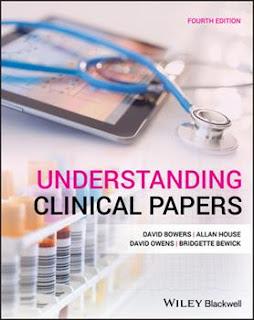Understanding Clinical Papers
David Bowers, Allan House, David Owens, and Bridgette Bewick. 2021. 4th ed. Wiley Blackwell. [ISBN 978-1-119-57316-6. 290 pages, including index. US$50.00 (softcover).]
As we navigate the post pandemic world of vaccines and global health awareness, an understanding of clinical studies becomes relevant to all people, whether formally educated in research studies or not. The study of an idea/product/process on human subjects in a clinical trial is the final step before something is introduced into human society. This complex process is outlined in Understanding Clinical Papers written by both quantitative and qualitative experts in their respective clinical fields: David Bowers, Allan House, David Owens, and Bridgette Bewick.
This book now in its fourth edition is a comprehensive, detailed account of how to read and understand both qualitative and quantitative clinical research. For anyone who wrote labs in school many of the headings and chapters will be familiar. The book’s unique characteristics arise from a collaboration between four researchers with different areas of clinical specialization. Since the first edition was published more than twenty years ago, the authors have added entire chapters in new statistical analyses for study results and qualitative research. Much of the initial setup and results analysis differs between qualitative and quantitative research, and it is noticeable to have both analyzed and even synthesized together in current clinical research projects.
The first half of Understanding Clinical Papers explains the study design, research subjects, results identification, and methods of measurement. Initially, a reader will check superficial outcomes of the study: Are the results significant, is it worth reading, is it relevant and is it ethical? How do the researchers layout their initial hypothesis—or if not investigating a hypothesis—is it clear what new ideas or questions they are trying to generate for the future? Throughout the text, the authors use an effective technique of illustrating a particular concept—a segment of a clinical paper is featured as a numbered table/figure with text bubbles and arrows. The text bubbles are connected with arrows to specific sections of the table/figure where the topic of interest is used in the clinical research. In this way, a relevant example of the featured topic is shown from current clinical literature.
The second half of the book covers results analysis and the complexities of statistical significance. In this section, some advanced knowledge of mathematics and statistics is helpful as the clinical data have often been subjected to a computerized statistical analysis. The authors sum up the confusion of interpreting statistical analysis in the statement, “If you have trouble figuring out what it tells you, do not worry: no-one else can do any better than you” (p. 162). This refers to the use of odds ratios to explain results used primarily for the mathematical properties that are beyond the book’s scope. Knowing this, the explanation of the p-value, a critical component of making results “significant” helps us understand just how complex statistical analysis really is, “How then do we decide what constitutes strong enough evidence against the hypothesis to enable us to reject it? The evidence we use is a probability, known as a p-value. The p-value is the probability of getting any particular outcome ...when the hypothesis is true” (p. 182). Overall, the second half of the book outlines different clinical scenarios, their results analysis, and the interpretation of their p-values and derivatives.
Impressive that Bowers, et al, was able to incorporate such an all-encompassing topic in 273 pages plus an eight-page reference section and a nine- page index. It is detailed enough for an experienced researcher yet realistic for an ambitious, educated layperson wanting to better understand clinical research. A must-have for the shelves of health-care professionals and health-care enthusiasts of all levels.
Julie Kinyoun
Julie Kinyoun is an on-call chemistry instructor at various community colleges in Southern California. An avid reader, she enjoys reviewing books that help her become a better educator.

